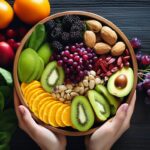Welcome to our informative guide on understanding food labels and making healthier choices for women’s nutrition. In today’s fast-paced world, navigating the many food options available and ensuring we are meeting our dietary needs can be challenging. That’s why food labels are crucial for women seeking to make informed decisions about their health and well-being.
Food labels provide valuable insight into the ingredients, nutrient content, allergens, and calorie information of the products we consume. By understanding how to interpret these labels, women can make choices that align with their specific dietary guidelines and optimize their nutrition.
This article will explore the key aspects of food labels that women should pay attention to, including deciphering ingredient lists, understanding nutrient content claims, identifying allergens and common intolerances, and decoding calorie information and serving sizes.
With this knowledge, women can confidently navigate the grocery store aisles, ensuring they select foods that support their health and dietary needs. So let’s dive into the world of food labels and empower ourselves to make healthier choices for better well-being.
The Basics of Food Labels
Understanding food labels is essential for women to make informed choices about their nutrition and meet their dietary needs. Food labels provide crucial information about the nutritional content of our packaged foods. By reading and interpreting these labels, women can make healthier decisions for themselves and their families.
One key component of a food label is the ingredient list. This list outlines all the ingredients used in the product, with the most abundant ingredient listed first. Women with specific dietary needs can carefully review the ingredient list to identify any potential allergens or substances they wish to avoid.
For example, a woman with gluten intolerance should pay close attention to the ingredient list to check for any gluten-containing grains like wheat, barley, or rye.
Food labels provide vital nutritional information in addition to the ingredient list. This information includes the serving size, the number of calories per serving, and the amount of macronutrients such as fat, carbohydrates, and protein. Women can use this information to manage their calorie intake and ensure they are meeting their nutritional requirements.
For instance, a woman following a low-carbohydrate diet may focus on products with lower carbohydrate content, while a woman trying to include more protein in her diet may choose more protein products.
Furthermore, food labels often display information about other important nutrients, such as vitamins and minerals. This information allows women to choose foods that offer a higher nutritional value and support their overall health.
In conclusion, understanding food labels and how to interpret the ingredient list and nutritional information is crucial for women to make informed choices about their nutrition and dietary needs. By utilizing the information provided on these labels, women can ensure they are selecting foods that align with their health goals and support their well-being.
Understanding Nutrient Content Claims
In this section, we will explore nutrient content claims found on food labels and how women can use them to make informed choices about the nutrient content of the foods they consume. Nutrient content claims provide valuable information about a product’s nutritional value and can help women make healthier choices for their nutrition needs.
So what do these claims mean? Nutrient content claims highlight specific nutrients in a food product, such as “high in fiber,” “low in sodium,” or “a good source of vitamins.” These claims are regulated by food authorities and are based on specific criteria that a product must meet.
Understanding these claims is essential for women who are conscious about their nutrition. Women can identify products that align with their dietary goals by paying attention to nutrient content claims. For example, a woman looking to increase her fiber intake can look for products that are “high in fiber.”
It’s important to note that nutrient content claims provide valuable information, but they should not be the sole basis for making food choices. When deciding their diet, women should also consider other factors like the overall ingredient list, portion sizes, and individual nutritional needs.
How to interpret nutrient content claims:
- Read the claim: Pay attention to the specific nutrient the claim highlights, such as “low fat” or “source of protein.”
- Understand the criteria: Familiarize yourself with the requirements a product must meet to make the claim. For example, a “low sodium” product may need to contain a specific amount of sodium per serving.
- Compare options: Use nutrient content claims to compare similar products and choose the one that aligns with your nutritional goals. For example, if you’re looking for a snack that provides a good source of vitamins, compare products labeled as such and choose the one with the highest vitamin content.
By understanding and utilizing nutrient content claims on food labels, women can make informed choices that support their nutrition goals and overall health.
Identifying Allergens and Common Intolerances
When it comes to food labels, understanding and identifying allergens and common intolerances is crucial for women’s nutrition and overall well-being. Allergens are substances that can cause an allergic reaction in certain individuals, while intolerances can lead to discomfort and digestive issues.
To ensure your safety and avoid any adverse reactions, it’s important to carefully read food labels and look for allergen information. Food manufacturers are required to clearly label the presence of common allergens such as peanuts, tree nuts, milk, eggs, wheat, soy, fish, and shellfish.
Here are some tips for identifying allergens in food labels:
- Check the ingredient list: Look for any mention of allergens or their derivatives. These may be listed in bold, capitalized, or highlighted to draw attention.
- Be aware of hidden allergens: Sometimes, allergens can be present in unexpected ingredients, such as milk derivatives in baked goods or soy in processed foods. Keep an eye out for any potential hidden allergens.
- Look for specific allergy statements: Some food labels may include statements like “Contains peanuts” or “May contain traces of milk.” These statements indicate the potential presence of allergens due to cross-contamination during manufacturing.
In addition to allergens, it’s essential to be aware of common intolerances, such as lactose or gluten intolerance. While these may not pose immediate health risks like allergies, avoiding certain ingredients can greatly improve comfort and digestive health.
A good practice is carefully reading the ingredient list for potential triggers. For example, if you have gluten intolerance, avoid wheat, barley, or rye foods.
By diligently reading food labels and understanding the presence of allergens and common intolerances, women can make informed choices that align with their dietary needs, ensuring a healthier and safer eating experience.
Decoding Calorie Information and Serving Sizes
When it comes to making healthy food choices, understanding the calorie information and serving sizes on food labels is essential for women to maintain their nutritional needs. This section will guide you through interpreting this vital information and help you make conscious decisions about portion control.
Interpreting Calorie Information
Calories provide us with energy, but consuming the right amount for our needs is crucial. Food labels show the total number of calories per serving. Knowing this information allows you to manage your calorie intake and make informed choices based on your health goals.
Keep in mind that calorie needs may vary depending on factors such as age, activity level, and overall health. It’s always a good idea to consult with a healthcare professional or registered dietitian to determine your specific calorie needs.
Understanding Serving Sizes
Serving sizes listed on food labels show the amount of food that is typically consumed in one serving. However, it’s important to note that serving sizes may differ from person to person based on individual dietary needs.
To make better-informed decisions about the calorie content of the food you consume, it’s crucial to compare the serving size on the label with the amount you actually eat. For example, if a serving size is half a cup, but you consume a full cup, you need to double the calorie information listed on the label to accurately understand the calorie content of your portion.
Practicing Portion Control
Being mindful of portion sizes can help women maintain a balanced diet and manage calorie intake effectively. You can adjust your portions according to your nutritional goals by understanding serving sizes and calorie information.
Here are a few tips for practicing portion control:
- Use measuring cups or a food scale to accurately portion your meals.
- Be mindful of large portion sizes when dining out or ordering takeout.
- Listen to your body’s hunger and fullness cues to avoid overeating.
- Create balanced meals with a variety of nutrient-dense foods.
By actively monitoring your portion sizes and making informed decisions about the calorie content of the foods you consume, you can align your diet with your individual nutritional needs.
Summary
In conclusion, understanding food labels is essential for women to make informed choices about their nutrition and overall health. By carefully examining ingredient lists, nutrient content, allergens, and calorie information, women can take control of their dietary choices and support their well-being.
Food labels provide valuable information about the ingredients used in a product, enabling women to make dietary decisions that align with their specific needs. Whether they have particular dietary restrictions or allergies or simply want to prioritize certain nutrients, food labels empower women to select foods that best suit their individual requirements.
Moreover, being able to interpret nutrient content claims on food labels allows women to identify foods that meet their nutritional goals. By understanding the meaning behind these claims, women can make conscious choices about the nutrient content of the products they consume.
By utilizing food labels as a valuable tool, women can make healthier choices that support their overall health and well-being. Whether it’s selecting foods with higher nutrient content, avoiding allergens, or regulating portion sizes, the information provided on food labels can guide women toward a more balanced diet and improved nutrition.











